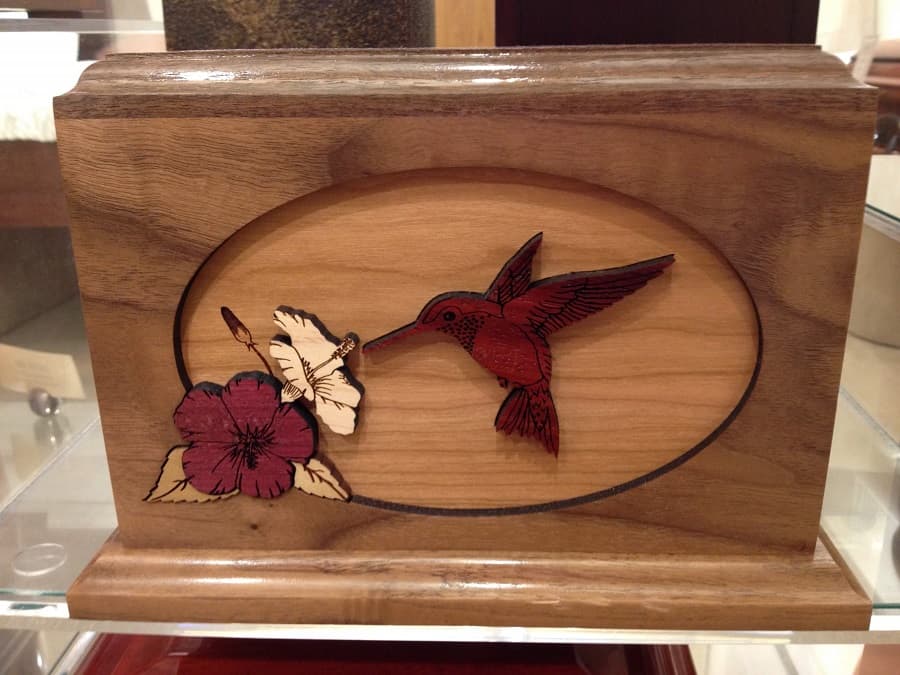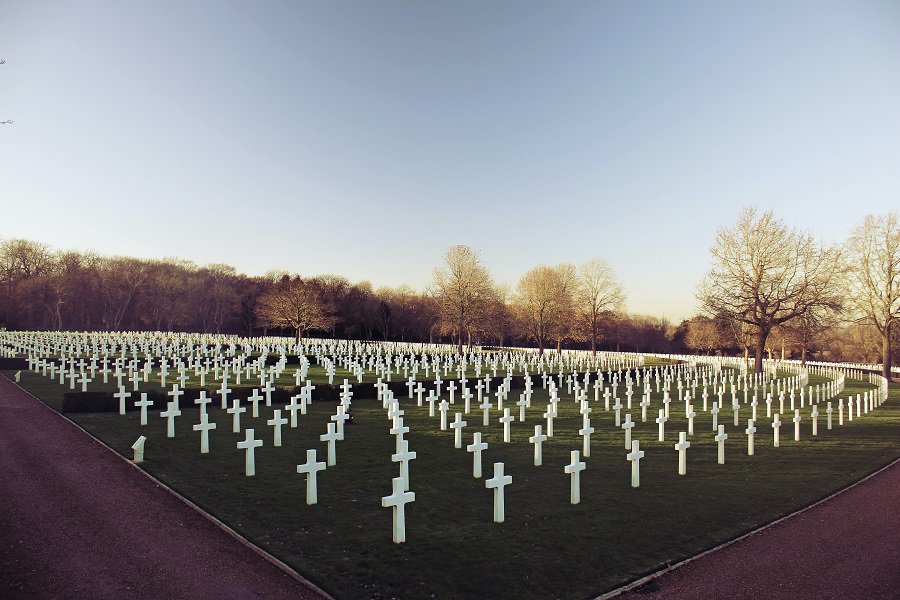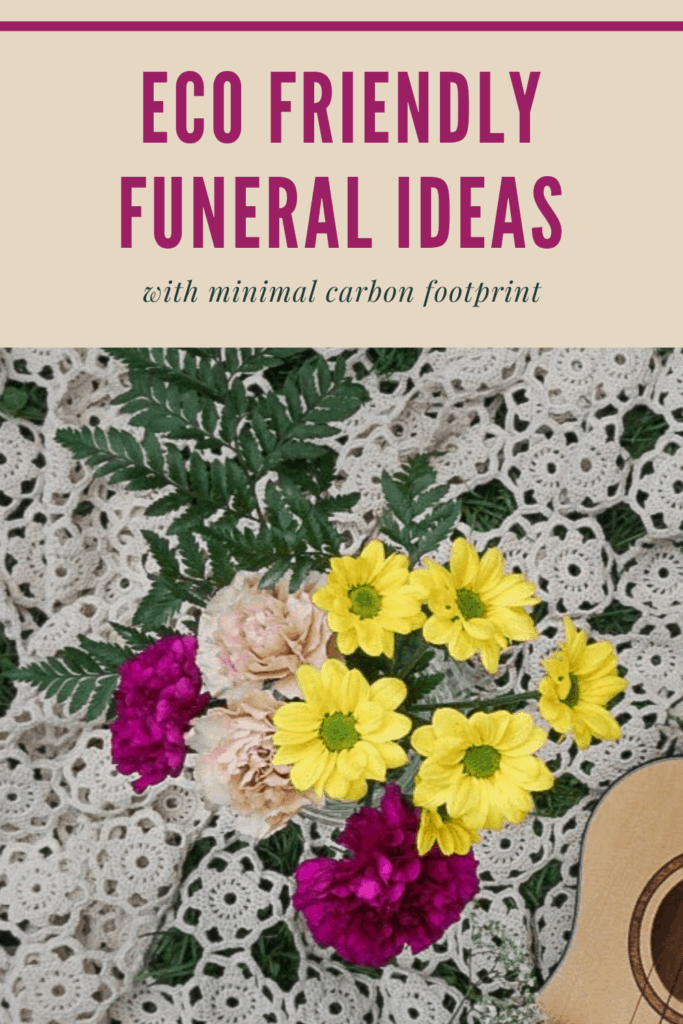The environmental impact of a typical funeral in North America is big. Whether you choose cremation or conventional burial there is a large source of greenhouse gas emissions and pollution generated. Graveyards are filling up around the world and use resources to maintain them indefinitely. Not to mention the abundant amount of imported fertilized cut flowers that decorate a funeral.
But there are better options. What people don’t realize is that there are more options than cremation and embalming / burial. Depending on where you live you can choose much greener alternatives like water cremation, human compost or natural burial in an eco pod or mushroom suit.
Knowing your options for end of life celebrations can help with the transition. There are choices you can make that allow you to avoid a large carbon footprint after death.
Preparing a Body
Over the years, the number of methods for preparing a human body for their final resting place have grown. Evidence of ancient methods of body preparation include the Egyptians using mummification, entombment and cremation. In the past century using chemicals to temporarily preserve a body and burying it became the norm.
In recent years with more environmental awareness combustion cremation is becoming more popular over embalming. But the practice of the final disposition of a dead body is an actively changing field and several methods have emerged that have less of a negative impact on the environment. Natural burials with the help of a mushroom suit or eco pod, or water cremation or even human composting are all promising techniques for the future.
Embalming
Embalming is the practice of preparing a body for viewing or transporting over a long distance. It is meant to stall the natural decomposition so that the body can be viewed after several days or transported. This method became popular after the Civil War when soldiers’ bodies needed to be transported back to their home.
This became the accepted form of treatment for a body in many places around the world including Canada and the United States. It is meant to temporarily preserve the body but after some time the body will still decompose.
In this method, blood is drained and embalming chemicals are injected into the arteries and veins. The body cavity is treated and any damaged surface areas are injected with embalming fluids. This process can take from two to four hours for a typical case, and it can take days for bodies that have had an autopsy, was a donor or incurred physical trauma.
The chemicals used to embalm a body typically include formaldehyde, methanol, glutaraldehyde and other solvents. Methanol is highly toxic even in small doses, formaldehyde can cause burns to the eyes and skin and is a known carcinogen. Embalmers need to be careful with personal protective equipment including chemical goggles, overalls, rubber boots and respiratory protection.
Sometimes formalin is used in embalming for cases where the body is being preserved for anatomical specimens. Formalin is a highly hazardous substance.
If a body needs to be repatriated from another country, there is a general international rule that the body must first be embalmed in order to travel. This is to make sure it will not carry any pathogens, viruses or bacteria.
The embalming industry often flushes the remaining liquids from embalming down the drain with the bodily fluids. These fluids enter the normal water treatment plant along with household waste water. These toxins have been found to leach into the waterways and air.
It is calculated that more than 4.3 million gallons of embalming fluids (800 thousand gallons of formaldehyde) are buried with dead bodies every year in the United States. Once again, the embalming fluids leach into waterways through the cemetery soil.
Emblaming costs vary depending on the injury sustained in death. A typical simple embalming costs about $800 USD. This is not a requirement by law but if you want to have an open casket service where people can view the body for grieving purposes, you will need to emblam.
For open casket funerals, the body will also have a makeup and hair stylist prepare them for viewing. This typically costs around $250 USD.
There is much debate about whether an open casket is necessary for the grieving process. Some say it is an important part of closure to see the body and say goodbye for the last time. But many societies that do not practice a viewing ceremony grieve just fine.
Often, seeing the body in an embalmed state is more traumatic for a griever than not seeing it at all. The embalming of a body cannot capture the person’s vibrancy, and often they are plastic-y, pale and thin. This memory of the person in a coffin will stay with you forever and that is not how the deceased would want to be remembered.
Cremation
Cremation has become the most popular choice for preparing the body for it’s final resting place in North America. Most people are recognizing the environmental impact of embalming and choosing to cremate instead. Plus it is significantly cheaper; the cost of cremation is less than embalming, you do not need a coffin, you do not pay extra for a viewing and the final resting place is smaller so less expensive if you choose to store them at a paid location.

Typical cremation (fire cremation) is the method of burning a dead body resulting in ashes. These ashes can be stored in a columbarium, stored in an urn at home or they can be spread in nature. The point is that the ashes represent the deceased person and the friends and family have flexibility over how they can visit for years to come.
But cremation has it’s own environmental impact. When a body is cremated, it is placed inside a container inside a closed furnace (cremator). This furnace is heated at a range of 1400 F degrees to 1800 degrees F. The container holding the body is directly exposed to a flame. After about 2 hours, all that remains are the ashes.
The cremation of one person produces about 534 pounds of carbon dioxide. Annually, that adds up to about 360 thousand metric tons of CO2 emissions each year.
As well, cremation produces several harmful air pollutants including sulfur dioxide and nitrogen oxides which have a much more devastating effect over carbon dioxide. (Nitrogen dioxide is 300 times worse than carbon dioxide)
For those bodies that had dental fillings, when cremated the fillings are heated up and released as vapor. Every year, 3.6 tons of mercury are released into the atmosphere due to cremation. Mercury is problematic in ecosystems and can be found in the body tissues of fish for example.
A study was done at a crematorium in the United Kingdom. The soil was sampled downwind from the crematorium and compared to the soil upwind. As predicted, the levels of mercury found in the soil was higher on the side that received the exhaust from the crematorium.
Cremation is responsible for 16 percent of the United Kingdom’s mercury pollution.
Other harmful compounds such as benzenes, furans and acetone are also emitted and filtering the crematorium fumes does little to reduce this.
The cost to cremate a body in Canada costs about $600.
Aquamation
Aquamation (alkaline hydrolosis or water cremation or bio cremation) is a newer and more enviornmentally friendly method of disposing of a dead body (over embalming and fire cremation). Similar to cremation, the body is put into a chamber but this one is filled with 95 percent water and 5 percent alkali and it does not require a casket. The water is heated between 200 and 300 degrees and gently circulated to dissolve the body’s blood and soft tissues. Only the bones, teeth and non organic materials (like dental fillings or surgical fittings) remain and can easily be picked out.
Many people think aquamation involves dissolving a body in acid. An alkali is NOT an acid and it is actually the water that does the dissolving.
This process can take between six to eight hours at 300 degrees F or 18 – 20 hours at 200 degrees F. When you compare this to a typical flame cremation (1600 degrees F for 3 hours), it does take longer but at a much lower temperature without any toxic emissions involved. Flame based cremation uses 90 percent more energy than aquamation.
Aquamation uses less water than the daily usage for a typical household.
The water that was used in the aquamation process is sterile and can be drained into the normal wastewater treatment facility. This tinted liquid contains peptides, amino acids, sugars and salts. It can actually be beneficial to the sewer systems because it improves wastewater. This liquid is sometimes taken away to be used as a fertilizer for a farm.
The process changes proteins into peptides and amino acids, carbs are reduced to sugars and fats are turned into salts. All DNA is totally broken down into their most basic forms. These basic building blocks make up 4 percent of the water solution (96 percent water) that is drained from the chamber.
The bone minerals that remain can be easily crushed into a powder and returned to the family. The ashes from this type of cremation are different than those of a flame cremation. They are more of a powder and whiter in colour (flame cremation is gray because it is not only the body that gets cremated, it is also a casket and clothing). There are typically more ashes involved with water cremation because flame cremation burns at such a high temperature.
Any mercury that remains in teeth due to dental treatment is not impacted by the aquamation process. The teeth can be removed from the remains at the end of the process and sent to be recycled. The release of mercury into the atmosphere is not an issue with aquamation as it is with cremation.
Another benefit to aquamation is that any medical implants can also be safely removed, cleaned and recycled. There is not any degradation through this process.
This type of cremation is used for pets and in agriculture. Animal carcasses can be sterilized to kill any bacteria and viruses with this method.
The cost to use water cremation as a method of preparing a body for their final resting place is about $1900 CAD. As this becomes a more accepted and common method, this price will go down but currently it is a growing practice that needs more support.
Human Composting
Human composting is a new technology set to be available in Washington state in 2021 that turns a human body into soil. The company doing this is called Recompose (also known as the Urban Death Project). They offer “natural organic reduction” services (known as recomposition). Recompose is a “benefit corporation” that takes care to have a positive impact on society, it’s workers, the environment and the community.
In the process offered by Recompose, a body is dropped into a modular and re-usable vessel, covered with wood chips and aerated. After about 30 days, the body is composted into a cubic yard of soil which can be used by the family in a garden.
This method of body disposition is safe for bodies that had viruses, cancer, antibiotics, pharmaceuticals and parasites. The only conditions that cannot use organic reduction are prion diseases or a highly contagious disease such as Ebola.
Any non-organics like surgical implants, dental fillings and prosthetics will be filtered out of the soil and recycled where possible. This thermophilic (heat loving) process does not cause toxic emissions and will not pollute groundwater like combustion cremation and embalming do.
In fact, even compared to natural burial (where a body is not embalmed but buried in a cloth in the earth), organic reduction performed the best in most categories like global warming potential. In a Life Cycle Assessment performed, a metric ton of CO2 will be saved each time someone is composted over cremated or buried.
The cost of the service will be about $5500 USD. This includes transportation of the body, filing the death certificate and time with family and friends at the event of commencing the recomposition. Their facilities are beautiful and make a good spot for a small celebration.
On their website, they compare the cost of green burial in Washington ($6000 USD), a cremation with ceremony can be $7000 and conventional burial with a coffin is around $8000).
As this option becomes more accepted and readily available, the cost will decrease.
Although this is not an option just yet, it is in the works and has the potential to remove the issues associated with all of the above methods of handling dead human bodies. Recompose is ready to take bodies from other states and countries.
Infinity Burial Suit (Mushroom Suit)
An Infinity Burial Suit is a cloth garment placed on a human body that has a special biomix infused in it. This biomix includes mushroom myceluim and other microorganisms that work together. When the body with the suit is buried, the mushrooms and microorganisms work to decompose the body, neutrilize toxins and create nutrient rich environments for plants to grow.
Mushrooms are known to decompose organic materials as well as clean contaminants in the environment. They occur in natural ecosystems to break down dead bodies and create healthy soil for plants to grow.
There is a famous TED Talk called My mushroom burial suit. This suit was later worked on and changed slightly to become the Infinity Burial Suit. This is a great TED Talk to get an overview of the basic concept.
The benefit to using an Infinity Burial Suit with a green burial is that the green burial alone (in a simple cloth shroud) does not account for the toxicity of a human body. Through a lifetime, a human body is a holder of BPA, mercury and 217 other toxic pollutants in our bodies (preservatives and pesticides included). The Infinity Burial Suit will clean these pollutants.
The choice of using an Infinity Burial Suit is part of a radical acceptance of death and decomposition called Decompiculture. Humans are intricately entwined with the environment and can be used to benefit nature after death.
The cost of an Infinity Burial Suit is $1500 USD.
Eco Burial Pods
Eco Burial Pods (Capsula Mundi) are egg shaped pods that are used to bury a corpse or ashes. A dead body is placed in the pod in fetal position and the pod is then buried with a seedling planted on top. The type of tree or plant used is decided by the deceased or their family.
This type of burial changes the look of a cemetery into a forest. This is much more eco friendly as it is not just a field of grass that needs to be watered and maintained but rather a diverse forest ecosystem.
An eco burial pod costs $457 USD.
Donation for Science
If you choose to donate your body to science your body will not be embalmed as it would for a funeral, but it might be preserved using a more toxic process.
The donation of a body to science saves the cost of burial or cremation and the cost of storing the body at the final resting place.
Plus, the advancements in science are often attributed to the use of cadavers.
Donation of Organs
If a body is donated for organs to be used to save another life, the rest of the body is returned to a family and they can then decide whether they want to embalm, cremate or use one of the other methods listed above.
Summary of the Advantages and Disadvantages to Each Method
| Advantages | Disadvantages | Burial | Cost | |
| Embalming | – commonly accepted – open casket – kills diseases | – high carbon footprint – pollutants, emissions – extremely toxic fluids used – expensive – dangerous job – requires final resting place in a coffin in a cemetery or mausoleum | yes | $800 USD $1090 CAD |
| Cremation (combustion) | – cleaner than embalming – cheaper than embalming and easier to store ashes | – toxic GHG and mercury emissions – uses more energy to heat furnace | no | $450 USD $600 CAD |
| Water Cremation (aquamation) | – no toxic emissions – less energy required – although the cost of preparing the body is higher, the total cost of final resting place is much less than burial | – not available everywhere yet | no | $1395 USD $1900 CAD |
| Composting (Urban Death Project) | – no toxic emissions – less energy required – negative carbon footprint | – seems more expensive but actually is comparable to other full services – not available yet | no | $5500 USD $7500 CAD |
| Infinity Burial Suit (Mushroom Suit) | – no toxic emissions – less energy required – cleans toxins that are in the body – creates healthy ecosystem for plants – available anywhere | – need to bury the body | yes | $1500 USD $2000 CAD |
| Eco Burial Pods | – biodegraable container used to bury a body – no toxic emissions | – not allowed in all areas – need to bury the body | yes | $457 USD |
Choosing a Final Resting Place
The preparation for the body was just the first step (and the first expense) in the process. Deciding where the final resting place for the deceased maybe an even more difficult decision.
For some families, if there is already a deceased member, it would be common to have them at the same place. But this is not always an option as cemeteries and mausoleums fill up and often don’t have any spots left.
Emtombment
Entombment in a modern urban setting can be at a mausoleum. A mausoleum is a large building used to store caskets. Some mausoleums are outdoor and some are indoors.
Indoor mausoleums are buildings that are heavy energy users requiring electricity and gas for lights and heating and air conditioning.
Family members and friends can visit comfortably at any time of the year becuse these sites are indoors. But the family has to pay for the space and it isn’t cheap ranging from $2000 to $20000 for an average crypt. This is a one time cost to house the casket forever. If you want a light to shine on the plaque you might need to pay an annual electricity fee.
Burial in a mausoleum requires that the body is in a coffin. If there is not sufficient ventilation, the coffin can “burp” as gases from decomposition build up. As the body decomposes inside the coffin, methane is released and builds up inside the coffin. If enough gas builds up, the coffin can even explode.
Burial at a Cemetery
Typical burial happens in a cemetery and requires the use of a coffin as well as a cement vault.

Most burial sites use an excavator to dig the grave. A machine is then used to carry the vault to the grave and then the casket is placed inside the vault and both are lowered into the earth. There is a significant amount of materials that are buried with each body (cement, metal, wood).
Heavily manicured grave sites require energy and resources to keep them in an acceptable state. Grass is usually grown needing water and fertilizer and tractors to cut them.
There are so many options for coffins, they might be made out of solid bronze, steel, hardwoods like mahogany, pine boards or even cardboard. Most coffins contain an outer shell (materials listed previously) and an inner lining like taffeta or velvet. to make the lining appear comfortable, polyester or cardboard may be stuffed into it as well.
After the inner and outer shell are assembled, the hinges, rubber seals and paint are applied.
All of these materials are only seen for a few days and then buried where they eventually leach into the ground soil and water over time.
Coffins range in price but the average coffin sold in the United States costs about $2000 USD.
Natural Burial Sites
Natural burials are becoming more popular but they are not legal in all areas. In this type of burial, the body is buried only in in a natural cloth, biodegradable casket, urn or shroud.
Some conventional cemeteries are now offering an area where natural burial is an option. Conservation Green Cemeteries are facilities that offer only natural burials. And there are also green friendly cemeteries that don’t have a natural burial section but they do allow a burial without the cement vault or embalming.
What to Do With Ashes?
For those bodies that have been cremated (combusion or water cremation) there is the choice about what to do with the ashes. There is a growing area of commercialism around ash storage with some very creative innovations.
Traditionally ashes are stored in an urn at the home of the family or friends of the deceased.
Another popular thing to do is to spread the ashes in a location (preferrably in nature) that means something to the deceased. This spreading of ashes is a ceremonial activity that can help with closure in the grieving process.
Newer methods are becoming more popular like turning the ashes into cremation jewelry, diamonds and memory glass. Some tattoo artists allow you to use the ashes in the tattoo ink. Memorial reefs are places where ashes can be built into a reef under water.
Some people even choose to add their ashes to fireworks or to be shot into space but I’m guessing these are not the people who are concerned about their carbon footprint!
Planting a tree in an ecological funeral urn is a great way to return the ashes to the earth while honouring a loved one.
There are many great options for urns to hold ashes. From eco friendly floating urns made from cotton and clay to biodegradable urns with a special scattering tube.
Flowers
I wanted to briefly mention the other part of the funeral process that is detrimental to the environment is the use of flowers. Although it is very nice to celebrate life with some natural beauty, the cut flower industry is typically hard on the environment.
Most of the flowers sold in the United States are grown overseas in industrial hot houses. They are treated with pesticides and chemicals and create dangerious working environments.
If you choose to use flowers at a funeral, try to get organic local, fair trade natural flowers.
Pets and Burial
And finally, I want to mention that if you are planning for the loss of a furry friend, some of the eco friendly options I talked about above are available for burying a pet.
You can purchase a Forever Spot by COEIO (the company that sells the Infinity Suits). This eco friendly cloth bag can be used to bury your pet in a special spot where they can decompse safely and improve the soil.

Casket at Cemetery Photo by Rhodi Lopez on Unsplash
Cemetery with White Crosses Photo by Neil Thomas on Unsplash
Recent Content
Green Parenting - Tips To Raising Environmentally Friendly Kids
It is more important now than ever to raise an environmentally conscious next generation. Children are the future so let's be sure to raise them with a respect of nature! To raise...
Thinking about buying a new (or used) car is a big decision for most people. It is one of the biggest purchases people make in terms of expense and ownership time. The options can be daunting...
